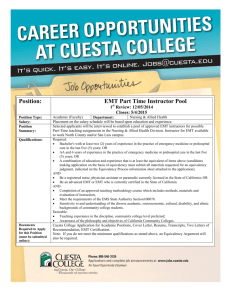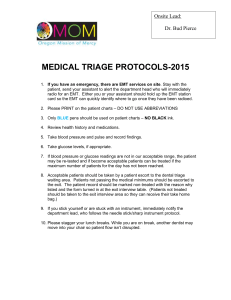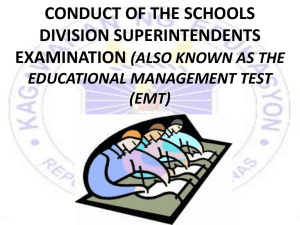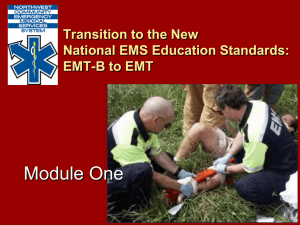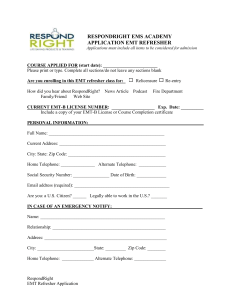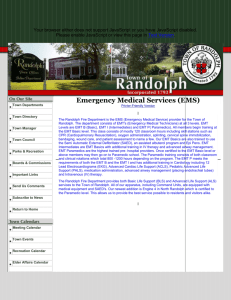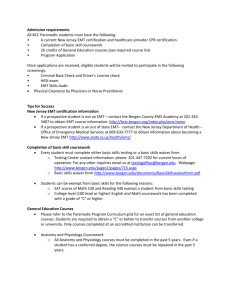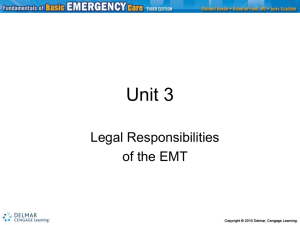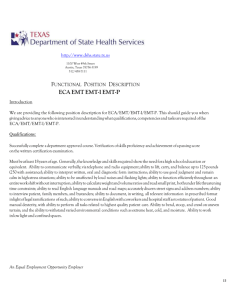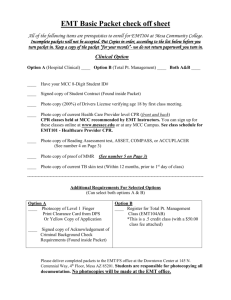AEMT Transition - Unit 14 - Critical Thicking
advertisement
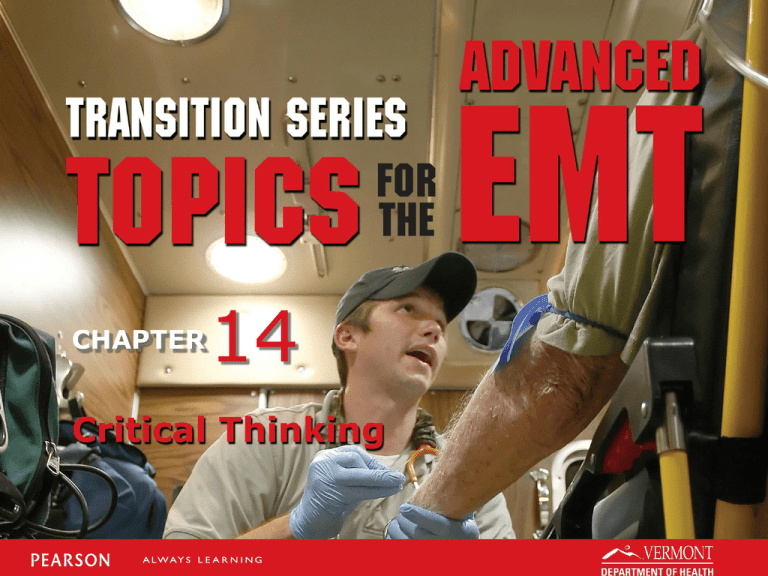
TRANSITION SERIES Topics for the Advanced EMT CHAPTER 14 Critical Thinking Objectives • Define critical thinking and how it relates to the Advanced EMT. • Understand the importance of determining life threats. • Discuss how to develop a differential diagnosis based on assessment findings. Introduction • Although difficult to define, critical thinking is an important skill for every EMS provider. • Assessment is not a static process; rather it is always dynamic. • The only steadfast rule is that life threats are addressed first. Introduction (cont’d) • As an Advanced EMT there are several ways to interview a patient to ascertain the true emergency at hand. • Always remember to address the life threats first and foremost. Critical Thinking Defined • Core Components of Critical Thinking – Medical inquiry – Clinical decision making – Clinical reasoning Advanced EMT as the Clinician • The Advanced EMT as a Technician – Approach to the patient is to find specific symptoms and provide specific treatment. – Protocol driven. • The Advanced EMT as a Clinician – Approach to the patient is to sort out puzzle pieces, evaluate potential treatment outcomes, prioritize, implement, and evaluate. Treat Life Threats First • Primary Assessment – Goal is to identify significant loss of function to airway, breathing, and circulation. – Support lost function first, progress to differentials second. – Consider an advanced airway as necessary. The primary assessment must be completed before any diagnostic steps are taken. Differential Diagnosis Process • Use presenting chief complaint as a direction of travel, not as a destination. – Patient with chest pain Technician – administer nitro Differential Diagnosis Process (cont’d) • Use presenting chief complaint as a direction of travel, not as a destination. – Patient with chest pain Clinician – consider nitro, but also consider cause of chest pain – Cardiac event – Pneumonia – Pneumothorax Differential Diagnosis Process (cont’d) • Use presenting chief complaint as a direction of travel, not as a destination – Patient with chest pain Clinician – consider nitro, but also consider cause of chest pain – Aortic dissection – Pulmonary embolus – Trauma Chest pain is one complaint for which a differential diagnostic approach is important. Developing Care Plans • Patient care is a balancing act, of sorts. – Needs vs. risks – Standing orders vs. online consults – On scene vs. ED care • Every clinical contact is a mystery waiting to be solved. Case Study • Your EMS squad is summoned to the home of an elderly female with altered mental status. You are met by the patient's daughter who states her mother has been lying in bed since last night and has been getting progressively weaker over the past 2-3 days. Case Study (cont’d) • Scene Size-Up – There is only one patient. – BSI precautions are taken. – Female patient, 72 years old, 145 lbs. – Lying supine in bed, seems to be sleeping. – Easy entry and egress with the patient. – No apparent MOI for fall or trauma. Case Study (cont’d) • What are some common differentials that could be considered at the outset for an elderly patient with an altered mental status? • What should be done next: narrow down the differentials with the SAMPLE history and OPQRST, or perform a primary survey? Case Study (cont’d) • Primary Assessment Findings – Patient responds to loud verbal stimuli, then drifts back off to sleep. – Airway patent and maintained by patient. – Respirations fast without accessory muscle use. Chest rise and fall normal. – Peripheral pulse is present, skin cool and clammy, skin is slightly pale. Case Study (cont’d) • Is this patient a high or low priority? Why? • What care should be provided immediately? • Is this patient in respiratory distress or failure? Why is this even important? Case Study (cont’d) • Medical History – Diabetic patient, previous “mini-strokes” • Medications – Patient takes insulin and aspirin daily • Allergies – Any narcotic type drug Case Study (cont’d) • Pertinent Secondary Assessment Findings – Pupils equal, sluggish to respond to light. – Breath sounds present bilaterally. – Peripheral perfusion is intact. – Patient has mild nausea but no vomiting. Case Study (cont’d) • Pertinent Secondary Assessment Findings – Pulse ox 97% on room air, BGL 140 mg/dL. – Skin cool, diaphoretic, pale. – B/P 92/80, Pulse 112, Respirations 24. Case Study (cont’d) • At this time, your partner, who just received his EMT certification, announces, “I think we need to give some oral glucose – after all, she is diabetic with an altered mental status.” • Do you agree or disagree? Defend your answer. Case Study (cont’d) • Consider these additional questions: – Has the patient been drinking fluids? – Has the patient been compliant with meds? – Has there been any change to bowel or bladder? – Did this ever happen before? Case Study (cont’d) • Has the patient been drinking fluids? – No significant oral intake of fluid. • Has the patient been compliant with meds? – Patient compliant with meds and BGL levels. Case Study (cont’d) • Has there been any change to bowel or bladder? – Patient has been passing blood in bowel • Did this happen before? – Patient was treated years before (not currently) for gastric ulcerations. Case Study (cont’d) • As it turns out, the patient has been passing large amounts of blood through the bowel, but did not tell the family this for fear of losing her independence and being moved into an elder care facility. It appears as if the old GI ulcer has been aggravated, perhaps made worse by the aspirin she takes daily. Without fluid intake, she would be even more dehydrated. Summary • Caring for patients is more than performing certain skills based on specific findings (technician approach). • To get to the underlying cause, the Advanced EMT will often have to overlook the obvious to uncover the true etiology of the emergency (clinician approach).

